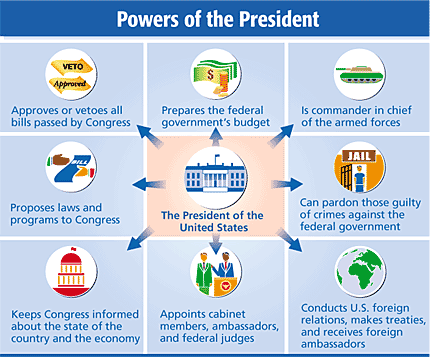2.4 Roles and Power of the President
3 min read•june 18, 2024
Jed Quiaoit
Akhilesh Shivaramakrishnan
AP US Government 👩🏾⚖️
240 resourcesSee Units
In this section, we will start discussing the executive branch, which is outlined in Article II of the Constitution. The key person here? The President of the United States. The powers outlined here for the executive branch are not as specific as those for the legislative branch, but there are some things the President can do! 🤩
After all, presidents have a wide range of powers and responsibilities that they can use to accomplish their policy agenda. As the head of the executive branch of the federal government, the president has the authority to make decisions and take actions that have a significant impact on the nation.
Presidential Powers
Veto Powers and Signing Statements
When a bill comes to the president’s desk, he has several options. The first option is likely the simplest - he can sign the bill into law within 10 days. They can also veto a bill. This means that the bill is sent back to Congress, which can override it with ⅔ majority in both houses (which is generally unlikely). 🙅🏻
- If the president does not sign the bill in 10 days and Congress is in session, the bill will become a law without the president’s signature.
- If the president does not sign the bill in 10 days and Congress adjourns within those 10 days, the bill will not become law.
This is called a pocket veto. The president can persuade Congress to modify a bill by threatening to veto the bill.
When the President does sign a bill, he/she can give his opinion on the law as well as his/her interpretation. It can also tell the executive branch how to enforce the law, and remember this is the main power of the executive branch.
Foreign Policy Powers
The President has several powers that fall into the realm of foreign policy. S/he is the commander in chief of the American military. However, the Constitution grants Congress the power to declare war. However, there have been several instances where troops were sent into armed conflict without a specific declaration of war from Congress (notably the Korean War and the Vietnam War).
The War Powers Act aims to give more power to the legislative branch by stating that there must be notification by the President to the legislative branch within 48 hours of deploying any troops 💬. This deployment can be for up to 60 days without a formal Congressional declaration. Money for war still comes from Congress! 💵
The President is also chief diplomat and can appoint ambassadors (with Senate confirmation), receive ambassadors, and recognize nations. Presidents often attend and host state visits to improve foreign relations.
Treaties and Executive Agreements
Treaties are formal and only the President, in his capacity as chief diplomat, is allowed to negotiate a treaty. It must be confirmed by the Senate with a ⅔ majority.
The Treaty of Versailles (Wilson) is a great example of this. On the other hand, executive agreements are more informal and are not approved by the Senate. It is not formal law, but is not binding. A great example of this is SALT I. 🎩
Executive Orders
Executive Orders are part of the President’s implied powers and allow for more management of the federal government.
They do not have to be approved by Congress, and is a way for the President to take more control of the actions of the federal government. 📜
Executive orders may therefore lead to conflict with Congress and their agenda (this is something that is stated within section 2.5 of the College Board’s Course Description, but fits well here).

Source: Weebly
🎥 Watch: AP GOPO - Presidential Roles and Powers
Browse Study Guides By Unit
🏛Unit 1 – Foundations of American Democracy
⚖️Unit 2 – Branches of Government
✊🏽Unit 3 – Civil Liberties & Civil Rights
🐘Unit 4 – American Political Ideologies & Beliefs
🗳Unit 5 – Political Participation
🤔Exam Skills

Fiveable
Resources
© 2025 Fiveable Inc. All rights reserved.